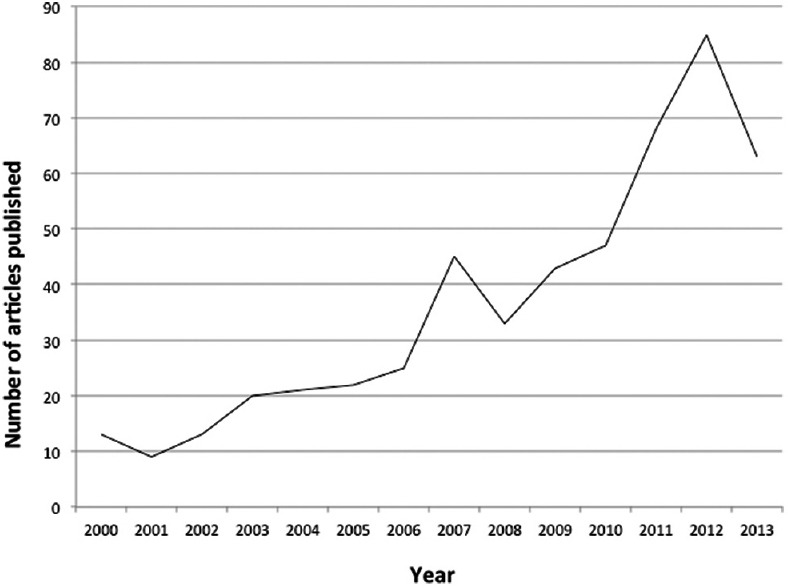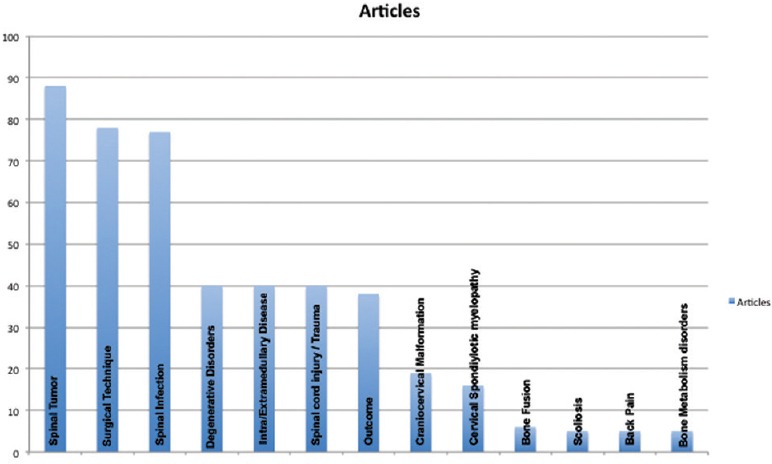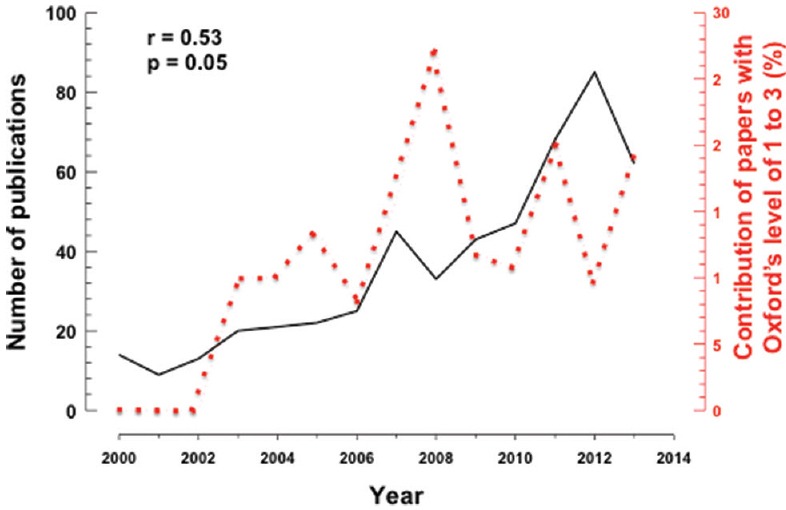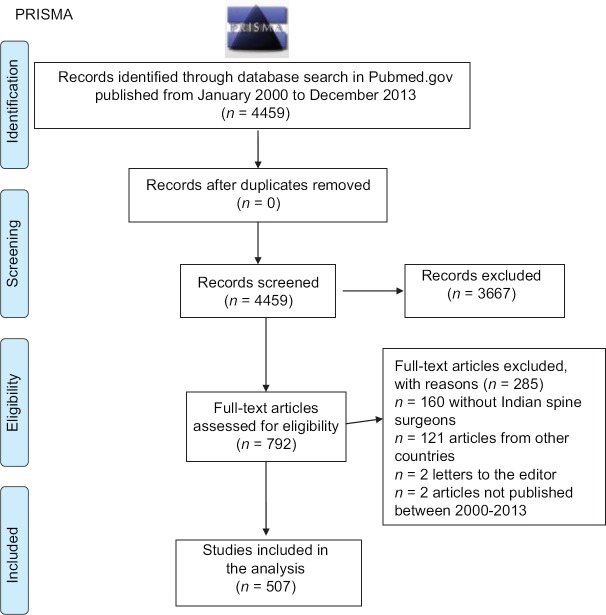Abstract
Background:
The number and quality of scientific publications reflects the standards of scientific research in a country. However, the contribution of Indian spine surgeons toward global publications is unknown. The goal is to study the publications of Indian spine surgeons between 2000 and 2013.
Materials and Methods:
A literature search of the publications by Indian spine surgeons was performed using MEDLINE. The search terms used were India and several spine-related terminologies. The main information of the selected papers including the year of publication, scientific journal, type of pathology studied, Neurosurgical or Orthopedic Department where the study was done, type of study, and the type of article was analyzed.
Results:
A total of 4459 articles were identified using MEDLINE and after exclusion, 507 articles were analyzed. A growth of 440% in the number of publications was observed in the period between 2009 and 2013, during which 60.15% of the articles were published. Clinical studies (n = 492; 97.04) were the most common types of articles, followed by experimental studies and other types. The Neurosurgery department published the majority of the articles (58.2%). The three most common pathologies studied were spinal tumors (17.35%), surgical technique (15.4%), and spinal infection (15.2%).
Conclusion:
The current study shows that publications in the field of spine surgery have been increasing in the last few years, although it is less. Further efforts such as research training of spine surgeons, inducing collaborations and formulation of multicenter projects and periodically allocating adequate funds are key factors to improve the scientific publications from India.
Keywords: India, MEDLINE, neurosurgery, orthopedics, publication, spine surgery
MeSh terms: Serial publications, surgeons, research, spine
INTRODUCTION
Scientific publications are one of the important indicators of scientific growth of that fraternity. The number of scientific publications contributed by each country toward the global output has become one of the critical indicators for assessing the strength of research in a nation. Developed countries such as the USA and the European Union Nations contribute to the majority of the scientific publications of the world.1 Surplus research funding, competitive research environment, and English proficiency are some of the main reasons behind the major research contributions from developed nations.2
According to the Department of Science and Technology (DST), India – 2012 report, India ranks currently 9th in the world based on its relative share of global publications.3 Chemistry, Physics, Material Science, Engineering, and Clinical Medicine are the active areas of research outputs from India. In the field of clinical medicine, spine surgery is a recently introduced specialty in India and is practiced by both orthopedicians and neurosurgeons. However, it is rapidly developing and has shown significant growth in the last decade. Though a large number of spine surgeries are performed every year, the contribution of spine surgeons toward the global spine literature is not known. The present study purports to study the patterns of publications pertaining to spine surgery over a 14-year period in India.
MATERIALS AND METHODS
We performed a literature search of the publications by Indian spine surgeons regarding spine or spinal cord topics using an online database: Pubmed.gov (http://www.ncbi.nlm.nih.gov/pubmed/). The results were stored and analyzed at the Laboratory of Clinical Studies and Basic Models of Spinal Disorders of the University of Caxias do Sul. Results were limited to articles published from January 2000 to December 2013. The search terms used were India* and (“spine” or “spinal diseases” or “spinal cord” or “spinal cord diseases” or “vertebroplasty” or “arthrodesis” or “diskectomy” or “foraminotomy” or “laminectomy” or “denervation” or “back injuries”).
At the first review, based on title and abstract, we excluded published articles that did not involve spine surgery. The articles considered potentially eligible were again analyzed and the articles without spine surgeons, letters to the editor, articles not published between 2000 and 2013, and articles from another country were also excluded [Figure 1]. The Indian spine surgeons were defined as spine surgeons from the orthopedic or neurosurgical specialties in which the paper was affiliated to an orthopedic or neurosurgical service.
Figure 1.
A flow chart showing selection of articles from MEDLINE search, based on the inclusion criteria (PRISMA format)
The main information on the selected papers, such as the year of publication, scientific journal that published the papers, Neurosurgical or Orthopedic Department where the study was done, the type of study, the main pathology studied, the Oxford classification, and the type of article was entered in an Excel sheet. The pathologies studied in the articles were classified as: (1) Spinal cord injury/trauma (2) degenerative and idiopathic scoliosis (3) spinal tumor (4) spinal infection (5) back pain (6) craniocervical malformation (7) assessment of outcome (8) degenerative disorders (9) intra- or extra-medullary disease (10) bone fusion (11) surgical technique and (12) bone metabolism disorders.
The quality or level of evidence (LOE) of the articles was evaluated using the Oxford classification.1,2,3 The articles were classified as clinical studies, case reports, experimental studies, case series, reviews, technical reports, and meta-analyses. Those variables were analyzed by two independent authors and in case of discordance, the two reviewers discussed and found a consensus. The number of citations per article was obtained from the Scopus web site (http://www.scopus.com).
Statistical analyses were conducted with SPSS version 20.0 (Armonk, New York, IBM Corporation). Categorical variables were presented as number and proportion. Linear-by-linear association tests and ANOVA test were conducted to verify improvement in the quality of publications in the 14-year period.
RESULTS
A total of 4459 articles were identified by the MEDLINE search. Reasons for exclusion of the articles are shown in Figure 1. After exclusion, 507 articles, published in the MEDLINE database by Indian spine surgeons from 2000 to 2013 were extensively analyzed.
The number of articles published according to the year of publication is shown in graph [Figure 2]. An increasing number of publications has been observed between 2000 and 2013: 60.15% of the articles were published between 2009 and 2013, 28.8% between 2004 and 2008, and 11.04% between 2000 and 2003. Compared to the period of 2000 and 2003, a growth of 440% in the number of publications by Indian spine surgeons was observed between 2009 and 2013.
Figure 2.

A graph showing number of articles published from 2000 to 2013
Clinical studies (n = 492; 97.04%) were the most common types of articles, followed by experimental studies (n = 13; 2.56%) and other types of studies (n = 2; 0.39%). Among the 13 papers defined as experimental studies, 5 (38.6%) were defined as biomechanics, 4 (30.7%) as animal studies, 3 (23.0%) as genetic studies, and 1 (7.7%) as a molecular study. The main institutes responsible for the publication of the articles were the All India Institute of Medical Sciences (6.6%), Ganga Hospital (5.8%), Sanjay Gandhi Postgraduate Institute of Medical Sciences (5.8%), Christian Medical College and Hospital (4.6%), and the Postgraduate Institute of Medical Education and Research (3.2%).
The pathologies studied in the articles are described in Figure 3. The three most common pathologies studied were spinal tumors in 17.35% of the cases (n = 88), followed by surgical technique in 15.4% (n = 78), and spinal infection in 15.2% (n = 77). Of the 507 articles, 50 (9.9%) were not included in the previous classification and were labeled as others. Analysis of the Oxford classification demonstrated that most papers provided LOE 5 (n = 281, 55.4%), followed by LOE 4 (n = 158, 31.2%), LOE 3 (n = 55, 10.9%), LOE 2 (n = 11, 2.3%), and LOE 1 (n = 2, 0.2%). The median number of citations per article was of 4.0 with an interquartile range of 9.0. The Pearson r coefficient analysis showed a correlation between the number of publications and the papers classified at the Oxford LOE 1, 2, and 3 with significant results and positive association [Figure 4].
Figure 3.

A bar diagram showing classification of the articles based on the main pathology studied
Figure 4.

Graph showing correlation between the articles published in the period from 2000 to 2013 and the articles with level of evidence 1, 2, and 3
DISCUSSION
A country's advancement and economic progress depend on its development in the field of science and technology, which is determined by the strength of its scientific research. An important indicator of a healthy scientific research environment is the number and quality of scientific publications from the different fields of science.4 India is making rapid strides in clinical medicine and has become a popular center for medical tourism for the quality and affordability of its health care services. However, quality of health care needs to be constantly evaluated and appraised through meticulous documentation and periodical research, which are currently weak in India. Further, disease patterns and patient demands vary for each country. Hence, there is a need for high quality research at both the clinical and basic science level in large numbers from India to develop specific solutions for its local demands and improve its scientific strength.5 In the DST report, it was observed that India's share of world research output declined between 1981 and 1995. China's scientific growth surpassed India and by 2010, China's share of world research output was ranked 2nd only to the USA.6 However, India's global share of publications started to increase after 2000, rising to 3.5% by 2010.
Spine surgery is a rapidly developing branch of clinical medicine and falls under the domain of both orthopedic and neurosurgeons. The present study was initiated to study the patterns of publications in the field of spine surgery in the last 14 years. This will help the surgeons to understand the need for more high-quality studies, the areas that require attention, improve the existing standards of research practices, and formulate steps to enhance research works.
The number of articles which met the inclusion criteria for the present study was 507 over a 14-year period. Even though the number is low, an increasing number of publications has been observed from 2009 (60.15% of the articles were published between 2009 and 2013). This corresponds to a growth of 440% in the number of publications, which is a very positive and encouraging sign. Most of the publications are clinical studies (97.04%). This probably indicates lack of personnel, research funding, and expertise to perform basic research studies. It is essential to understand that basic science research is not exclusively laboratory based and it is actually a prelude to clinical research. The integration of basic and applied research is crucial to problem-solving and innovation.7
The pathologies studied in the articles reflect the common patterns of diseases observed in the Indian sub continent. The three most common pathologies studied were spinal tumors (17.35%), surgical technique (15.4%), and spinal infection (15.2%). Since neurosurgeons contributed to the majority of publications, spinal tumors remain the most common pathology studied. A limitation of the study is that we did not include a wide array of other search terms such as deformity, scoliosis, kyphosis, myelomeningocoele, dysraphism, tuberculosis, caries, and trauma. This could have resulted in missing some publications and can result in selection bias. However, we preferred to use more general keywords (e.g., spine) due to the fact that those basic keywords were automatically linked to other more specific ones. If more specific keywords such as tuberculosis were included, we would have a larger number of papers to review unnecessarily, since it would have shown many publications with unrelated and nonspinal pathologies.
A study on the patterns of publications in the field of medicine in India showed that the number of articles published has increased from 10046 (2001–2005) to 19273 (2005–2010), which indicates a 92% increase. The percentage share of clinical medicine publications from India toward the global share is 1.9%. Though there is a tremendous improvement in the number of publications, a cause of concern is the quality of publications. Quality of publications can be gauged by three parameters: The number of publications in top 1% journals, percentage of noncited articles, and the levels of evidence of the articles. The relatively low share of India in top 1% journals has been a matter of concern. The share of Indian publications in top 1% impact making journals was only 0.54% in 2001, though it had increased from 2610 (2001–2005) to 4723 (2005–2010).3 A second factor to ascertain the quality of publications is the percentage of papers which do not receive any citation. Degree of noncitedness of publications from developed countries is generally in the range of ~25%. However in India, the percentage of papers which do not receive any citation is 47.3%.3 In the present study, it was observed that most of the studies published in spine surgery provided a low quality of evidence, wherein only 13 articles provided level 1 or level 2 evidence. High quality research providing grade 3 and above evidence are required to improve the standards of research in India. This would call for multipronged approaches such as to discourage submissions to low impact factor journals, stimulate submissions to high impact journals, and to increase the citation profiles of national journals.
Another reason for the poor performance is the lack of international collaboration from India on the research front. The Diagnostic Study Report states that India's international collaboration is less frequent than for many established economies. In 2001–2005, 18.8% of Indian research publications were internationally co authored and this increased marginally to 19.5% by 2006–2010.3 In addition, the government's expenditure on scientific research accounts for only 1.2% of gross domestic product in 2012, which is much less than in developed nations.3
There are several possible reasons for the less number of publications and less optimal quality of published studies. The lack of a competitive research environment in India is an important factor. Very few doctors are interested in collecting and analysing their clinical data, leave alone performing a basic science research. A paradoxical problem for India is the current lack of human resources, i.e., the availability of qualified researchers. Lack of incentives, career growth independent of research activities and publications, and shortage of mentors are important reasons for the unavailability of qualified researchers. Lack of English proficiency is another major impediment toward publications. The majority of indexed journals are in English and it has been shown in previous studies that language deficiency is a major factor for the smaller number of publications from Asian countries. In a study by Man et al., it was found that there was a significant relationship between national spending on research and English test scores and the publication output of developed countries.2 These two variables explained approximately 71.5% of the variation in publication rate across developed nations around the world. English-speaking nations had the highest rate of publication in the five highest ranked general medical journals whereas Asian countries had generally low rates of publication. Research spending and English proficiency were strongly associated with publication output in the highest ranked general medical journals.2
Disease epidemiology, healthcare needs, patient's affordability, and expectations differ for each country and India has unique healthcare demands. At present, there is an excessive dependency on scientific information derived from studies in the Western countries, which is less likely to provide solution to local problems. India needs to generate its own scientific knowledge base adapted to the local healthcare needs. Major policy decisions toward promoting health care research, appropriate allocation of funds, training of personnel, incentives, and creation of competitive environment of research are required to improve the current existing standards.
CONCLUSION
The current study shows that publications in the field of spine surgery are increasing in the last few years. A significant growth of 440% was observed in the period between 2009 and 2013, which is a good sign of improvement in the research and publication environment in the field of spine surgery. Clinical studies were the most common types of articles published, which indicates the need for more stress on basic science and experimental studies in the future. To contribute significantly to the global share of publications, serious efforts are needed such as providing better conditions for research training, identifying areas of research, stimulating collaborations, formulating multicenter projects, promoting joint scientific activities, and improving fund allocation for research.
Financial support and sponsorship
Nil.
Conflicts of interest
There are no conflicts of interest.
REFERENCES
- 1.Holmgren M, Schnitzer SA. Science on the rise in developing countries. PLoS Biol. 2004;2:E1. doi: 10.1371/journal.pbio.0020001. [DOI] [PMC free article] [PubMed] [Google Scholar]
- 2.Man JP, Weinkauf JG, Tsang M, Sin DD. Why do some countries publish more than others? An international comparison of research funding, English proficiency and publication output in highly ranked general medical journals. Eur J Epidemiol. 2004;19:811–7. doi: 10.1023/b:ejep.0000036571.00320.b8. [DOI] [PubMed] [Google Scholar]
- 3.New Delhi: Department of Science and Technology, Government of India; 2012. Government of India. Bibliometric Study of India's Scientific Publication Outputs during 2001-10 – Evidence for Changing Trends. [Google Scholar]
- 4.Gaillard J. Measuring research and development in developing countries: Main characteristics & implications for the Frascati manual. Science, Technology and Society. 2010;15(1):77–111. [Google Scholar]
- 5.Kumar N, Asheulova N. Comparative analysis of scientific output of BRIC countries. Ann Library Inf Stud. 2011;58:228–36. [Google Scholar]
- 6.Cheng T. Increased Chinese orthopaedic research output during 2000-2009: A survey of scientific publications from China. Orthop Traumatol Surg Res. 2012;98:253–8. doi: 10.1016/j.otsr.2011.12.002. [DOI] [PubMed] [Google Scholar]
- 7.Franzoni C, Scellato G, Stephan P. Science policy. Changing incentives to publish. Science. 2011;333:702–3. doi: 10.1126/science.1197286. [DOI] [PubMed] [Google Scholar]



